Flood-Prone Zones of Meandering Rivers: Machine Learning Approach and Considering the Role of Morphology (Kashkan River, Western Iran)
Abstract
:1. Introduction
2. Materials and Methods
2.1. Study Area
2.2. Random Forest (RF)
2.2.1. Flood Conditioning Factors
- The aspect plays a crucial role in flood mapping as it indicates the direction of each pixel in relation to a unit degree [13]. By considering the aspect map, which encompasses eight directions (N, NE, E, SE, S, SW, W, NW), we can determine the slope direction for more precise decision-making (Figure 2a). Each pixel within the aspect map is assigned a value ranging from −1 to 360, representing the specific direction it faces. The number −1 is commonly employed to represent flat or undetermined regions lacking a distinct slope direction. Such areas might encompass depressions, hollows, or flat terrains where identifying a sole slope direction is not feasible.
- The slope of an area plays a significant role in influencing the speed of drainage and the duration it takes for inundation to occur. Areas with flat or low slopes tend to be more susceptible to inundation, as water accumulates and drains at a slower pace. On the other hand, regions characterized by steep slopes facilitate rapid water drainage and the occurrence of high-velocity flows. In our present study, we employed the degree measurement to calculate the slope using a Digital Elevation Model (DEM) specific to the study area (Figure 2b).
- The geomorphon method is a relatively new approach for classifying surface landforms. It relies on pattern recognition principles and was developed by Jasiewicz and Stepinski [40]. This method utilizes a DEM as its input. It examines the elevation of a specific cell in the DEM and compares it with the surrounding cells in eight different directions up to a specified search radius. By employing a three-part pattern, the geomorphon method describes the type of landform at a given cell location [41] (Figure 2c). Geomorphons can be useful in identifying flood-prone areas due to their ability to characterize surface landforms. The landform information is valuable for assessing the topography of an area and understanding how water flows across the landscape. For instance, low-lying areas with gentle slopes and depressions can indicate potential floodplains. By analyzing the distribution and characteristics of different landforms, flood-prone regions can be identified more effectively.
- Plan curvature, also referred to as surface curvature, describes the divergence or convergence of flow patterns within a given geographical region [40]. The plan curvature provides valuable insights into the behavior of water flows and helps the algorithms to identify flood-prone areas more efficiently (Figure 2d). A plan curvature with a positive value shows that the surface is curving outwards at that cell, appearing convex from the side. Conversely, a negative value indicates that the surface is curving inwards, appearing concave from the side. A value of zero signifies that the surface is linear.
- The profile curvature metric quantifies the slope gradients along the maximum slope direction. Negative values signify a convex slope, indicating the outward curvature, whereas positive values denote a concave slope, indicating the inward curvature. A cell with a profile curvature of zero suggests a linear slope, lacking any curvature. Figure 2e shows the profile curvature of the studied area.
- In order to assess the topographic influences on hydrological processes [43], we employed the topographic Wetness Index (TWI). The TWI serves as a quantitative measure to capture the impact of topography on water flow (Figure 2g). Generally, higher TWI values are indicative of areas prone to flooding.
- Flooding susceptibility is significantly influenced by elevation [44]. Generally, regions situated at lower elevations are more susceptible to flooding in comparison to more elevated areas. In our study, the Shuttle Radar Topography Mission (SRTM) digital elevation model was utilized as the raster layer to represent elevation data (Figure 2h).
- The Surface Texture Index serves as a quantitative metric to depict the roughness or variation of a DEM surface. This index enables the representation of spatial variability across the terrain and is particularly advantageous for analyzing topographic features at different scales (Figure 2i).
2.2.2. Training Data Collection
2.2.3. Flood Map Generation
2.3. Validation and Accuracy Assessment
3. Results
4. Discussion
4.1. Model Capability to Identify Flood-Prone Areas
4.2. Impact of Topography on Inundation
5. Conclusions
Author Contributions
Funding
Data Availability Statement
Acknowledgments
Conflicts of Interest
References
- Lazzarin, T.; Defina, A.; Viero, D.P. Assessing 40 Years of Flood Risk Evolution at the Micro-Scale Using an Innovative Modeling Approach: The Effects of Urbanization and Land Planning. Geosciences 2023, 13, 112. [Google Scholar] [CrossRef]
- Arnell, N.W.; Gosling, S.N. The impacts of climate change on river flood risk at the global scale. Clim. Chang. 2016, 134, 387–401. [Google Scholar] [CrossRef]
- Ha, J.; Kang, J.E. Assessment of flood-risk areas using random forest techniques: Busan Metropolitan City. Nat. Hazards 2022, 111, 2407–2429. [Google Scholar] [CrossRef]
- Esfandiari, M.; Abdi, G.; Jabari, S.; McGrath, H.; Coleman, D. Flood Hazard Risk Mapping Using a Pseudo Supervised Random Forest. Remote Sens. 2020, 12, 3206. [Google Scholar] [CrossRef]
- Khosravi, K.; Panahi, M.; Golkarian, A.; Keesstra, S.D.; Saco, P.M.; Bui, D.T.; Lee, S. Convolutional neural network approach for spatial prediction of flood hazard at national scale of Iran. J. Hydrol. 2020, 591, 125552. [Google Scholar] [CrossRef]
- Amitrano, D.; Di Martino, G.; Iodice, A.; Riccio, D.; Ruello, G. Unsupervised rapid flood mapping using Sentinel-1 GRD SAR images. IEEE Trans. Geosci. Remote Sens. 2018, 56, 3290–3299. [Google Scholar] [CrossRef]
- CEOS. The Use of Earth Observing Satellites for Hazard Support: Assessments & Scenarios. 2018. Available online: http://drm.cenn.org/Trainings/Multi%20Hazard%20Risk%20Assessment/Lectures_ENG/Session%2002%20Spatial%20data%20requirements%20for%20risk%20assessment/background/CEOS_DMSG_Final_Hazards_Report10_02.pdf (accessed on 20 June 2023).
- Ghahraman, K.; Nagy, B. Flood risk on arid alluvial fans: A case study in the Joghatay Mountains, Northeast Iran. J. Mt. Sci. 2023, 20, 1183–1200. [Google Scholar] [CrossRef]
- Khosravi, K.; Pourghasemi, H.R.; Chapi, K.; Bahri, M. Flash flood susceptibility analysis and its mapping using different bivariate models in Iran: A comparison between Shannon’s entropy, statistical index, and weighting factor models. Environ. Monit. Assess. 2016, 188, 656. [Google Scholar] [CrossRef]
- Feng, Q.; Gong, J.; Liu, J.; Li, Y. Flood Mapping Based on Multiple Endmember Spectral Mixture Analysis and Random Forest Classifier—The Case of Yuyao, China. Remote Sens. 2015, 7, 12539–12562. [Google Scholar] [CrossRef]
- Rafiei-Sardooi, E.; Azareh, A.; Choubin, B.; Mosavi, A.H.; Clague, J.J. Evaluating urban flood risk using hybrid method of TOPSIS and machine learning. Int. J. Disaster Risk Reduct. 2021, 66, 102614. [Google Scholar] [CrossRef]
- Deroliya, P.; Ghosh, M.; Mohanty, M.P.; Ghosh, S.; Rao, K.D.; Karmakar, S. A novel flood risk mapping approach with machine learning considering geomorphic and socio-economic vulnerability dimensions. Sci. Total Environ. 2022, 851, 158002. [Google Scholar] [CrossRef] [PubMed]
- Farhadi, H.; Najafzadeh, M. Flood risk mapping by remote sensing data and random forest technique. Water 2021, 13, 3115. [Google Scholar] [CrossRef]
- Lee, S.; Kim, J.-C.; Jung, H.-S.; Lee, M.J.; Lee, S. Spatial prediction of flood susceptibility using random-forest and boosted-tree models in Seoul metropolitan city, Korea. Geomat. Nat. Hazards Risk 2017, 8, 1185–1203. [Google Scholar] [CrossRef]
- Khosravi, K.; Pham, B.T.; Chapi, K.; Shirzadi, A.; Shahabi, H.; Revhaug, I.; Prakash, I.; Bui, D.T. A comparative assessment of decision trees algorithms for flash flood susceptibility modeling at Haraz watershed, northern Iran. Sci. Total Environ. 2018, 627, 744–755. [Google Scholar] [CrossRef]
- Cao, C.; Xu, P.; Wang, Y.; Chen, J.; Zheng, L.; Niu, C. Flash flood hazard susceptibility mapping using frequency ratio and statistical index methods in coalmine subsidence areas. Sustainability 2016, 8, 948. [Google Scholar] [CrossRef]
- Mangukiya, N.K.; Sharma, A. Flood risk mapping for the lower Narmada basin in India: A machine learning and IoT-based framework. Nat. Hazards 2022, 113, 1285–1304. [Google Scholar] [CrossRef]
- Goffi, A.; Stroppiana, D.; Brivio, P.A.; Bordogna, G.; Boschetti, M. Towards an automated approach to map flooded areas from Sentinel-2 MSI data and soft integration of water spectral features. Int. J. Appl. Earth Obs. Geoinf. 2020, 84, 101951. [Google Scholar] [CrossRef]
- Zhang, M.; Chen, F.; Liang, D.; Tian, B.; Yang, A. Use of Sentinel-1 GRD SAR images to delineate flood extent in Pakistan. Sustainability 2020, 12, 5784. [Google Scholar] [CrossRef]
- Singha, M.; Dong, J.; Sarmah, S.; You, N.; Zhou, Y.; Zhang, G.; Doughty, R.; Xiao, X. Identifying floods and flood-affected paddy rice fields in Bangladesh based on Sentinel-1 imagery and Google Earth Engine. ISPRS J. Photogramm. Remote Sens. 2020, 166, 278–293. [Google Scholar] [CrossRef]
- Twele, A.; Cao, W.; Plank, S.; Martinis, S. Sentinel-1-based flood mapping: A fully automated processing chain. Int. J. Remote Sens. 2016, 37, 2990–3004. [Google Scholar] [CrossRef]
- Voigt, S.; Kemper, T.; Riedlinger, T.; Kiefl, R.; Scholte, K.; Mehl, H. Satellite image analysis for disaster and crisis-management support. IEEE Trans. Geosci. Remote Sens. 2007, 45, 1520–1528. [Google Scholar] [CrossRef]
- Wang, Z.; Lai, C.; Chen, X.; Yang, B.; Zhao, S.; Bai, X. Flood hazard risk assessment model based on random forest. J. Hydrol. 2015, 527, 1130–1141. [Google Scholar] [CrossRef]
- Rawat, S.; Saini, R.; Singh, A. Mapping of Waterlogged Areas and Silt-Affected Areas After the Flood Using the Random Forest Classifier on the Sentinel-2 Dataset. In Machine Intelligence Techniques for Data Analysis and Signal Processing: Proceedings of the 4th International Conference MISP 2022, Online, 12–14 March 2022; Springer Nature: Singapore, 2023; Volume 1. [Google Scholar]
- Arlisa, S.D.; Handayani, H.H. Flood Vulnerability Analysis using Random Forest Method in Gresik Regency, Indonesia. In IOP Conference Series: Earth and Environmental Science; IOP Publishing: Bristol, UK, 2023. [Google Scholar]
- Mirkazemi, S.M.; Jalalkamali, N.; Irandoost, M. Spatial Flood Forecasting Modeling under Lack of Data Using RS and Optimized Support Vector Machine: A Case Study of the Zahedan Watershed. Nat. Hazards Rev. 2023, 24, 05023005. [Google Scholar] [CrossRef]
- Youssef, A.M.; Pradhan, B.; Dikshit, A.; Mahdi, A.M. Comparative study of convolutional neural network (CNN) and support vector machine (SVM) for flood susceptibility mapping: A case study at Ras Gharib, Red Sea, Egypt. Geocarto Int. 2022, 37, 11088–11115. [Google Scholar] [CrossRef]
- Sarigöl, M.; Yesilyurt, S.N. Flood routing calculation with ANN, SVM, GPR, and RTE methods. Pol. J. Environ. Stud. 2022, 31, 5221–5228. [Google Scholar] [CrossRef]
- Ghosh, A.; Dey, P.; Ghosh, T. Integration of RS-GIS with Frequency Ratio, Fuzzy Logic, Logistic Regression and Decision Tree Models for Flood Susceptibility Prediction in Lower Gangetic Plain: A Study on Malda District of West Bengal, India. J. Indian Soc. Remote Sens. 2022, 50, 1725–1745. [Google Scholar] [CrossRef]
- Filipova, V.; Hammond, A.; Leedal, D.; Lamb, R. Prediction of flood quantiles at ungauged catchments for the contiguous USA using Artificial Neural Networks. Hydrol. Res. 2022, 53, 107–123. [Google Scholar] [CrossRef]
- Breiman, L. Random forests. Mach. Learn. 2001, 45, 5–32. [Google Scholar] [CrossRef]
- Feng, Q.; Liu, J.; Gong, J. UAV remote sensing for urban vegetation mapping using random forest and texture analysis. Remote Sens. 2015, 7, 1074–1094. [Google Scholar] [CrossRef]
- Rodriguez-Galiano, V.F.; Ghimire, B.; Rogan, J.; Chica-Olmo, M.; Rigol-Sanchez, J.P. An assessment of the effectiveness of a random forest classifier for land-cover classification. ISPRS J. Photogramm. Remote Sens. 2012, 67, 93–104. [Google Scholar] [CrossRef]
- Dehghani, R.; Torabi Poudeh, H.; Younesi, H.; Shahinejad, B. Forecasting daily river flow using an artificial flora–support vector machine hybrid modeling approach (case study: Karkheh Catchment, Iran). Air Soil Water Res. 2020, 13, 1178622120969659. [Google Scholar] [CrossRef]
- Geravand, F.; Hosseini, S.M.; Ataie-Ashtiani, B. Influence of river cross-section data resolution on flood inundation modeling: Case study of Kashkan river basin in western Iran. J. Hydrol. 2020, 584, 124743. [Google Scholar] [CrossRef]
- Hosseini, F.S.; Liu, Q.; Meng, F.; Yang, C.; Wen, W. Safeguarding the Intelligence of Neural Networks with Built-in Light-weight Integrity MArks (LIMA). In Proceedings of the 2021 IEEE International Symposium on Hardware Oriented Security and Trust (HOST), Tysons Corner, VA, USA, 12–15 December 2021. [Google Scholar]
- Fu, G.; Schmid, W.; Castellazzi, P. Understanding the Spatial Variability of the Relationship between InSAR-Derived Deformation and Groundwater Level Using Machine Learning. Geosciences 2023, 13, 133. [Google Scholar] [CrossRef]
- Trucchia, A.; Izadgoshasb, H.; Isnardi, S.; Fiorucci, P.; Tonini, M. Machine-Learning Applications in Geosciences: Comparison of Different Algorithms and Vegetation Classes’ Importance Ranking in Wildfire Susceptibility. Geosciences 2022, 12, 424. [Google Scholar] [CrossRef]
- Kia, M.B.; Pirasteh, S.; Pradhan, B.; Mahmud, A.R.; Sulaiman, W.N.A.; Moradi, A. An artificial neural network model for flood simulation using GIS: Johor River Basin, Malaysia. Environ. Earth Sci. 2012, 67, 251–264. [Google Scholar] [CrossRef]
- Jasiewicz, J.; Stepinski, T.F. Geomorphons—A pattern recognition approach to classification and mapping of landforms. Geomorphology 2013, 182, 147–156. [Google Scholar] [CrossRef]
- Luo, W.; Liu, C.-C. Innovative landslide susceptibility mapping supported by geomorphon and geographical detector methods. Landslides 2018, 15, 465–474. [Google Scholar] [CrossRef]
- Bui, D.T.; Lofman, O.; Revhaug, I.; Dick, O. Landslide susceptibility analysis in the Hoa Binh province of Vietnam using statistical index and logistic regression. Nat. Hazards 2011, 59, 1413–1444. [Google Scholar] [CrossRef]
- Otsu, N. A threshold selection method from gray-level histograms. IEEE Trans. Syst. Man Cybern. 1979, 9, 62–66. [Google Scholar] [CrossRef]
- Shafapour Tehrany, M.; Kumar, L.; Neamah Jebur, M.; Shabani, F. Evaluating the application of the statistical index method in flood susceptibility mapping and its comparison with frequency ratio and logistic regression methods. Geomat. Nat. Hazards Risk 2019, 10, 79–101. [Google Scholar] [CrossRef]
- Moghim, S.; Gharehtoragh, M.A.; Safaie, A. Performance of the flood models in different topographies. J. Hydrol. 2023, 620, 129446. [Google Scholar] [CrossRef]
- Mehrabi, A. Monitoring the Iran Pol-e-Dokhtar flood extent and detecting its induced ground displacement using sentinel 1 imagery techniques. Nat. Hazards 2021, 105, 2603–2617. [Google Scholar] [CrossRef]
- Mukherjee, S.; Joshi, P.K.; Mukherjee, S.; Ghosh, A.; Garg, R.; Mukhopadhyay, A. Evaluation of vertical accuracy of open source Digital Elevation Model (DEM). Int. J. Appl. Earth Obs. Geoinf. 2013, 21, 205–217. [Google Scholar] [CrossRef]
- Elkhrachy, I. Vertical accuracy assessment for SRTM and ASTER Digital Elevation Models: A case study of Najran city, Saudi Arabia. Ain Shams Eng. J. 2018, 9, 1807–1817. [Google Scholar] [CrossRef]
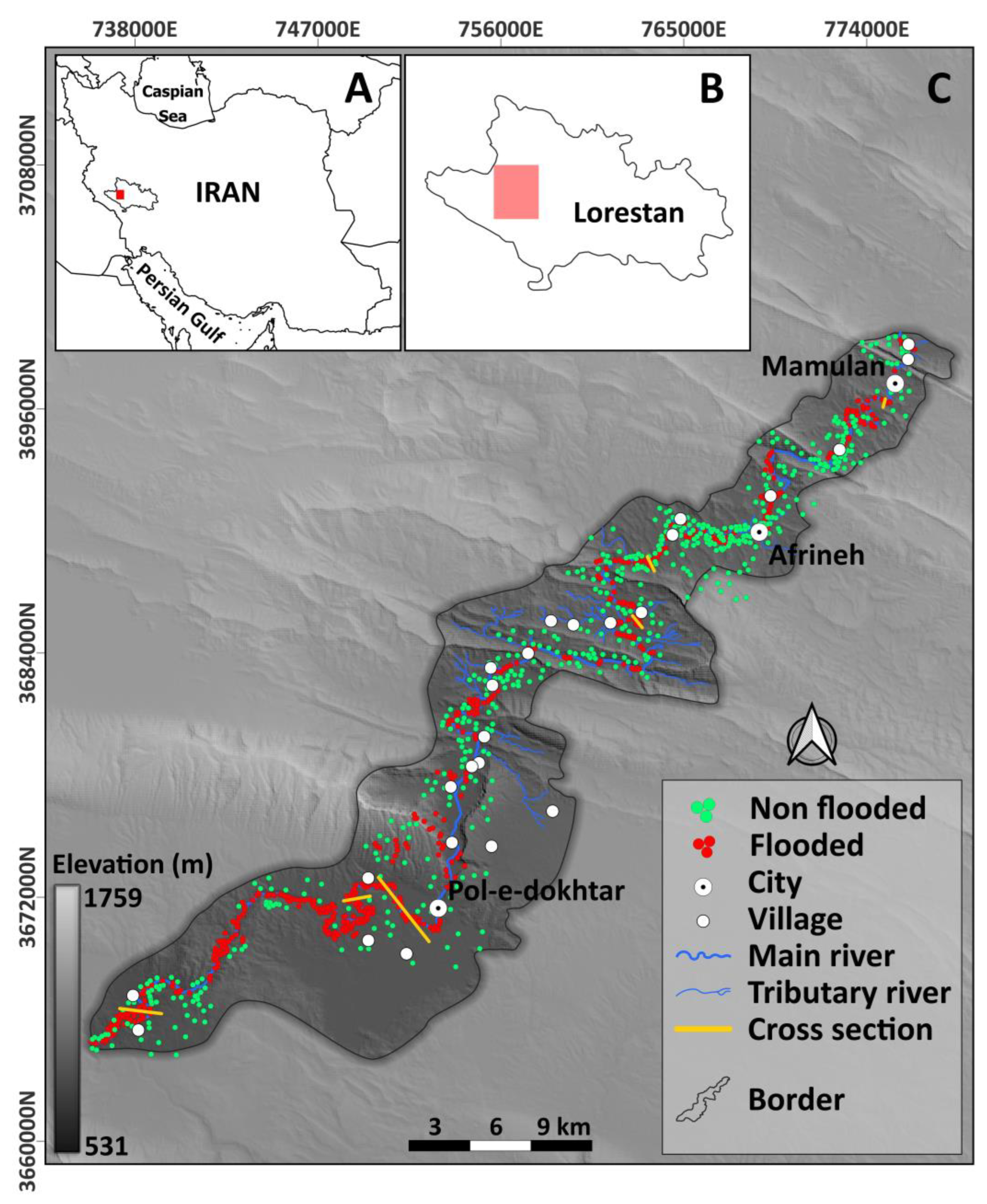
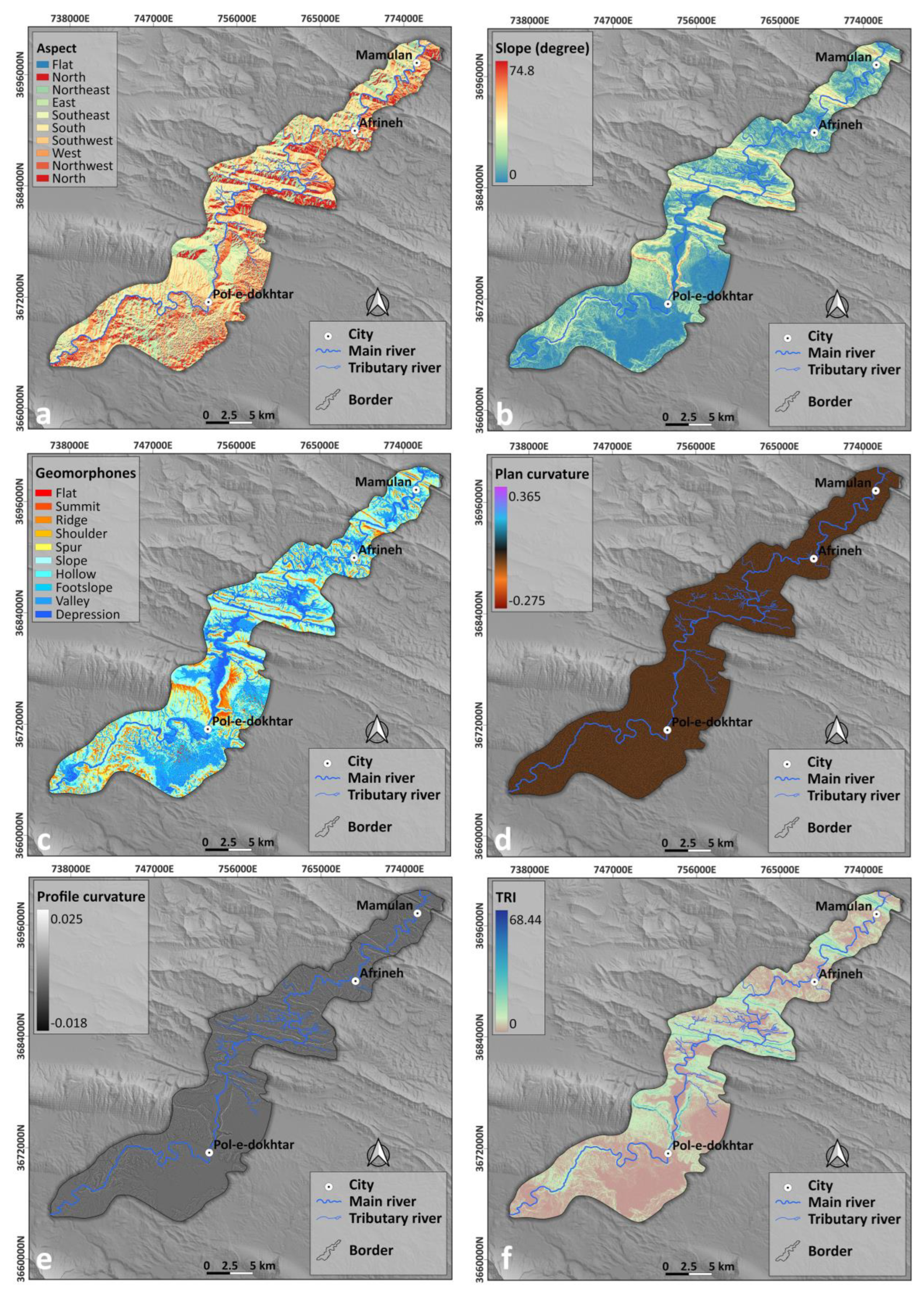
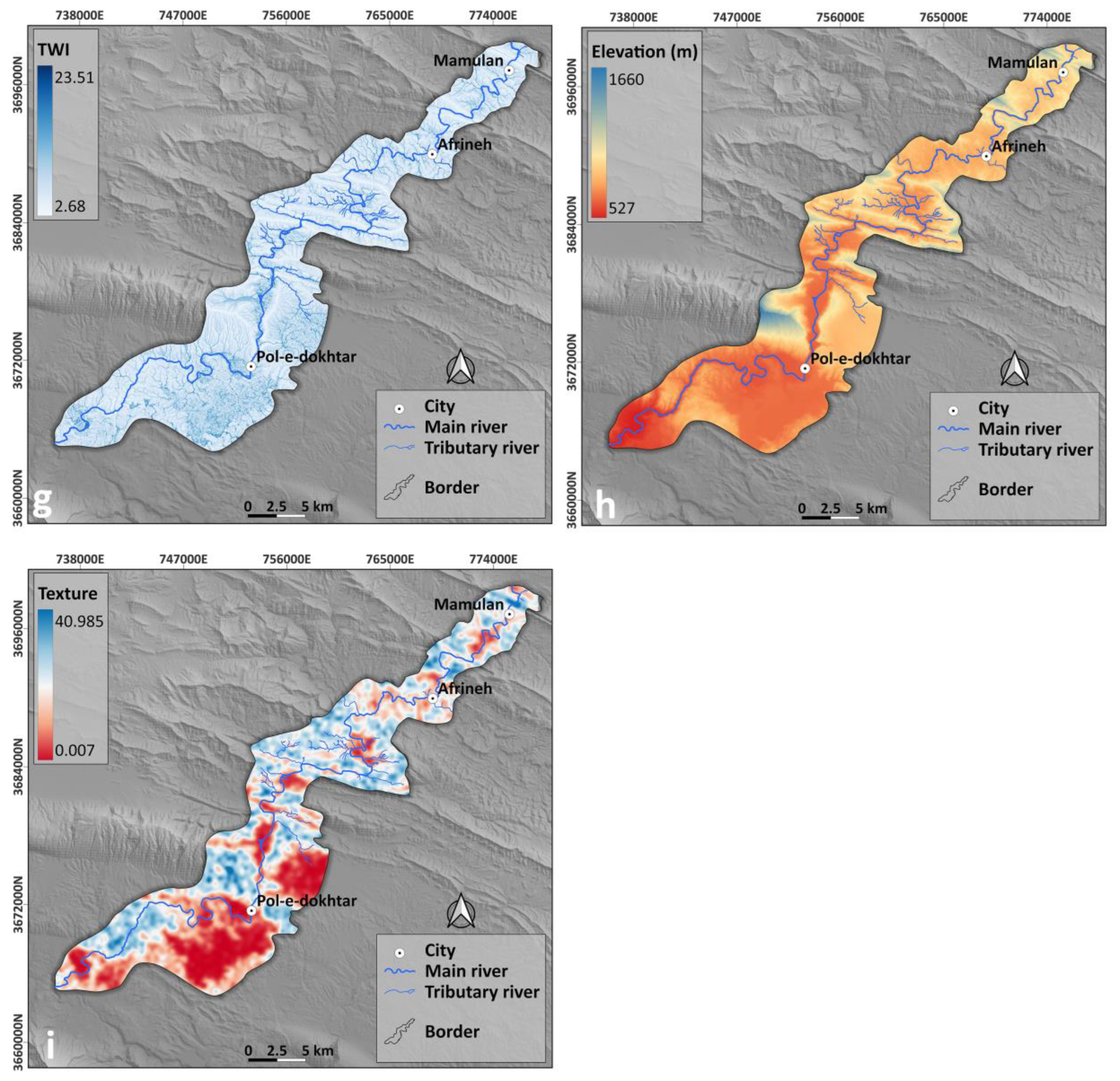
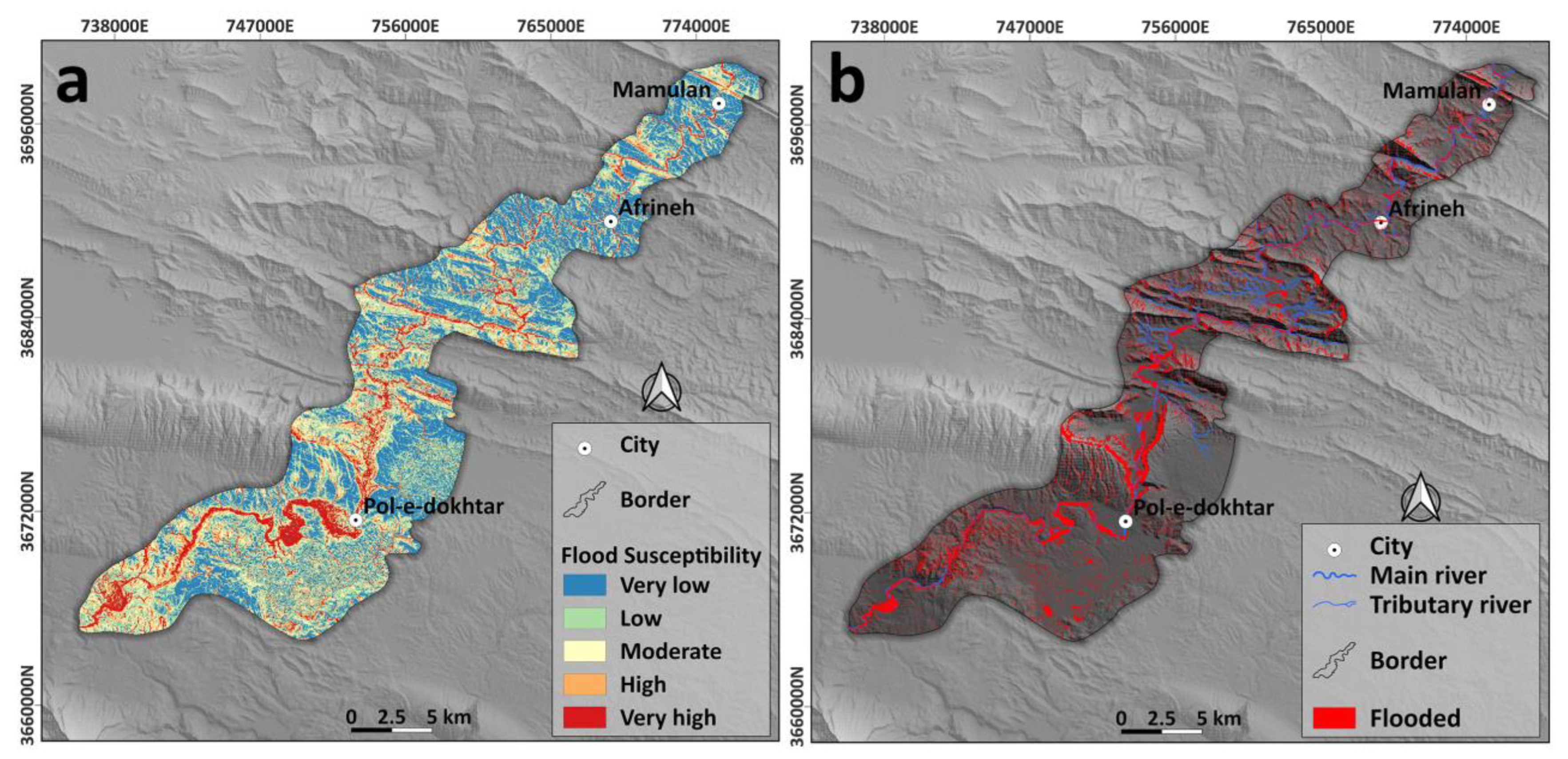
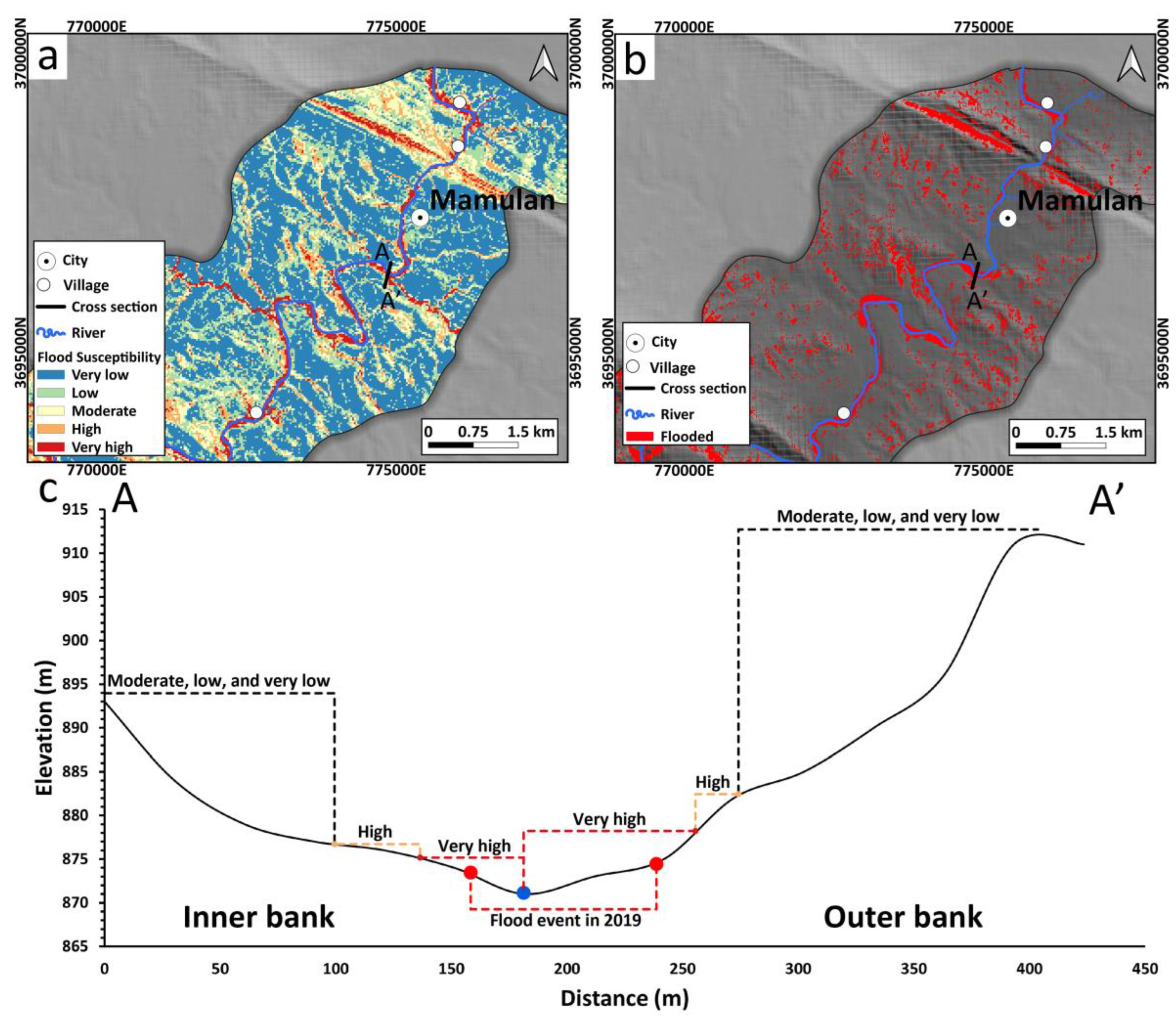
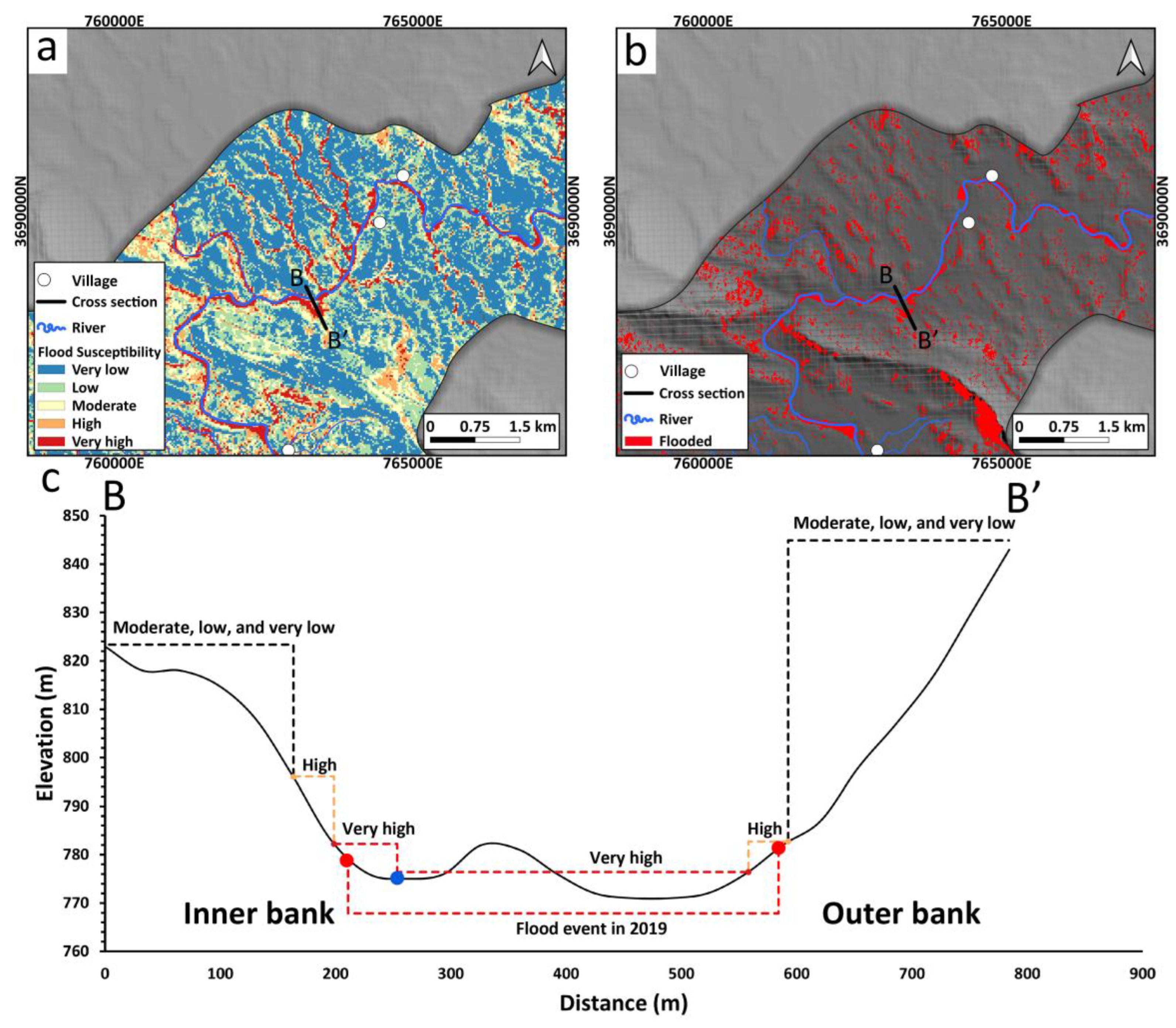
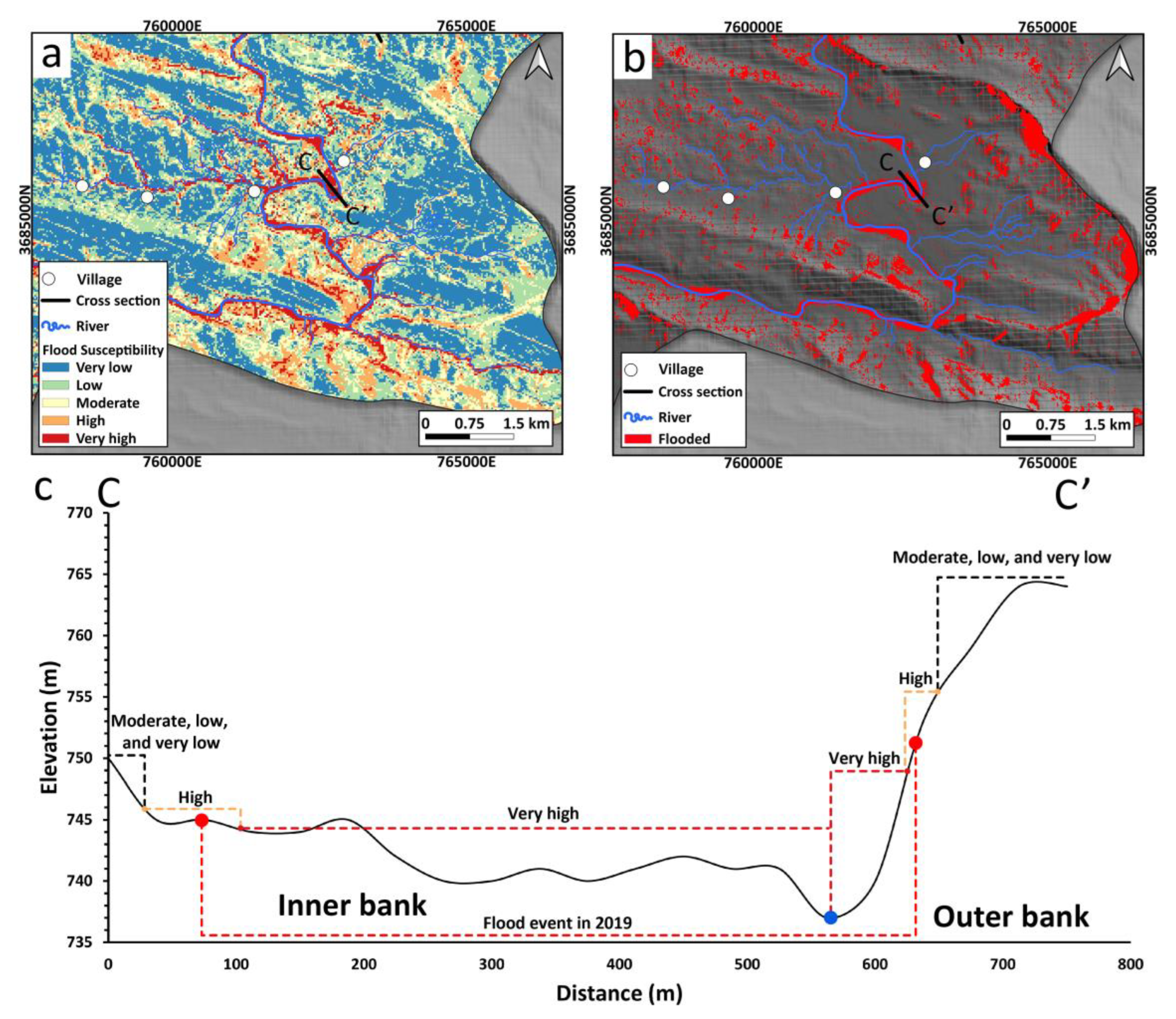
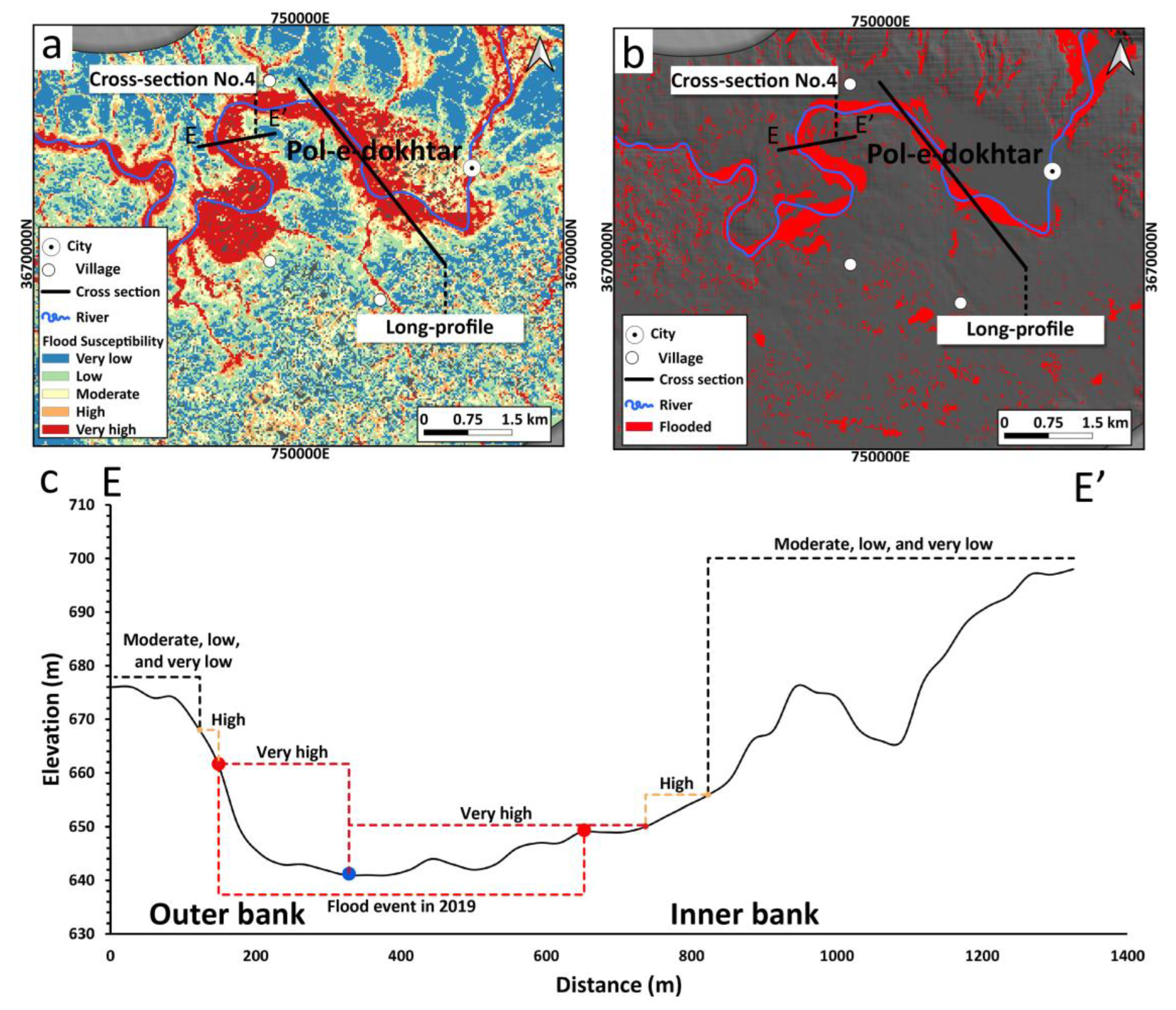
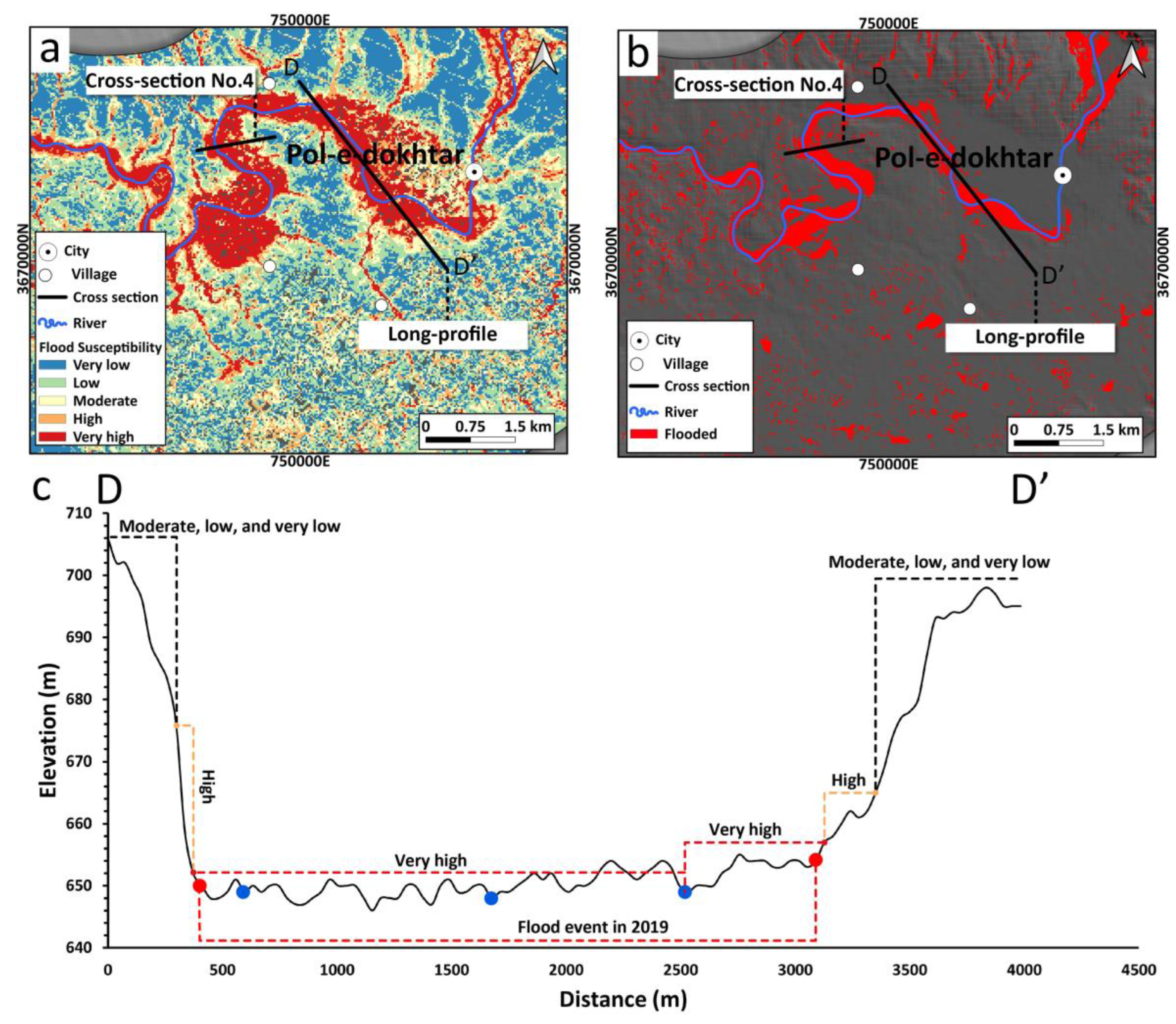
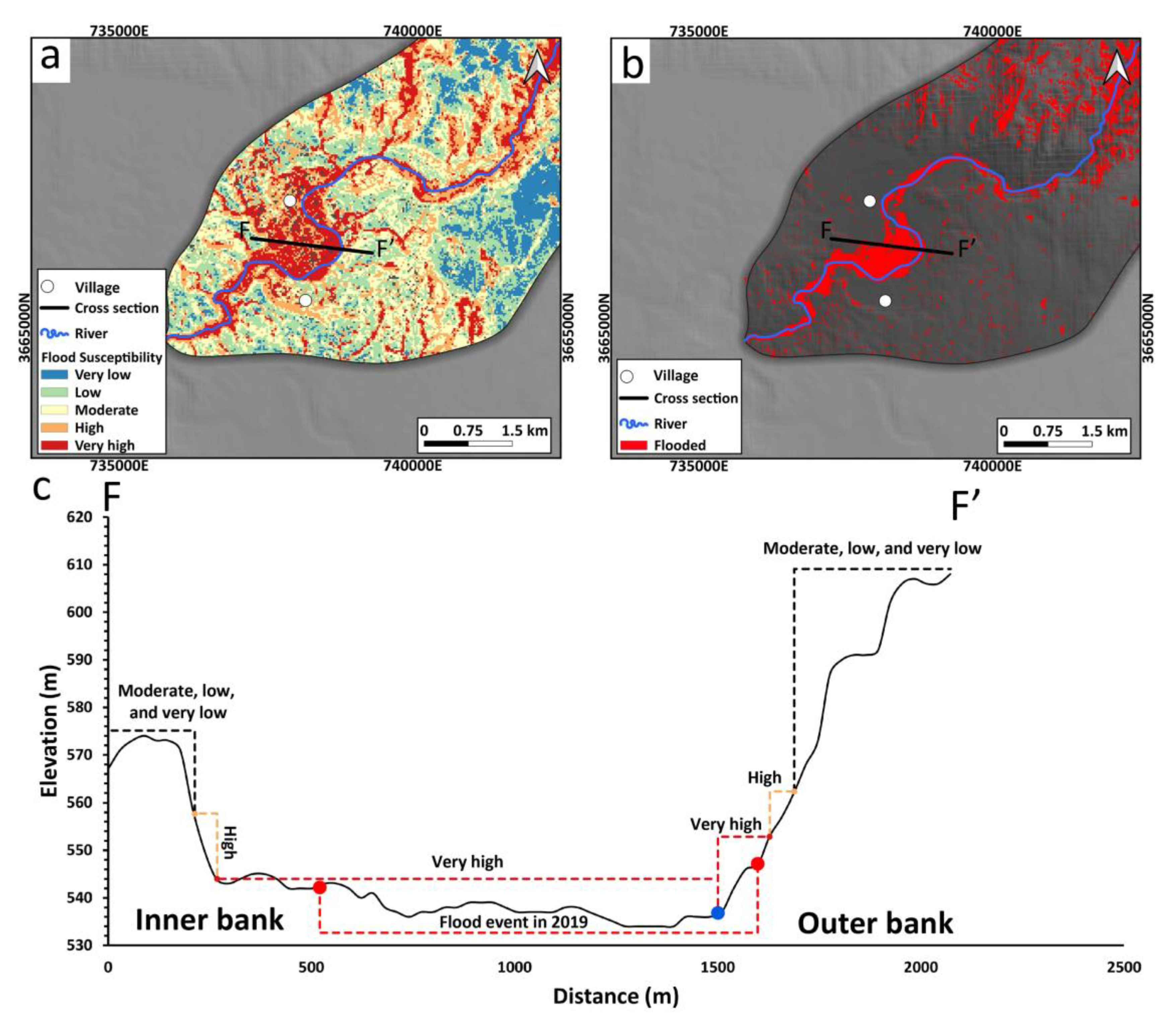
| Parameter | Value |
|---|---|
| AUC | 0.8656 |
| Sensitivity | 0.9236 |
| Specificity | 0.9 |
| Conditioning Factor | Mean Decrease Accuracy |
|---|---|
| Aspect | 22.41 |
| Slope | 20.67 |
| Geomorphons | 47.90 |
| Plan Curvature | 1.41 |
| Profile Curvature | 23.24 |
| TRI | 25.45 |
| Texture | 26.97 |
| TWI | 71.36 |
| Elevation | 79.49 |
| Class | Area km2 |
|---|---|
| Flooded/inundated (SAR) | 63.02 |
| Very high (RF) | 31.3 |
| High (RF) | 43.2 |
| Moderate (RF) | 62.59 |
| Low (RF) | 85.88 |
| Very low (RF) | 123.61 |
| Total area of the study area | 346.58 |
Disclaimer/Publisher’s Note: The statements, opinions and data contained in all publications are solely those of the individual author(s) and contributor(s) and not of MDPI and/or the editor(s). MDPI and/or the editor(s) disclaim responsibility for any injury to people or property resulting from any ideas, methods, instructions or products referred to in the content. |
© 2023 by the authors. Licensee MDPI, Basel, Switzerland. This article is an open access article distributed under the terms and conditions of the Creative Commons Attribution (CC BY) license (https://creativecommons.org/licenses/by/4.0/).
Share and Cite
Ghahraman, K.; Nagy, B.; Nooshin Nokhandan, F. Flood-Prone Zones of Meandering Rivers: Machine Learning Approach and Considering the Role of Morphology (Kashkan River, Western Iran). Geosciences 2023, 13, 267. https://doi.org/10.3390/geosciences13090267
Ghahraman K, Nagy B, Nooshin Nokhandan F. Flood-Prone Zones of Meandering Rivers: Machine Learning Approach and Considering the Role of Morphology (Kashkan River, Western Iran). Geosciences. 2023; 13(9):267. https://doi.org/10.3390/geosciences13090267
Chicago/Turabian StyleGhahraman, Kaveh, Balázs Nagy, and Fatemeh Nooshin Nokhandan. 2023. "Flood-Prone Zones of Meandering Rivers: Machine Learning Approach and Considering the Role of Morphology (Kashkan River, Western Iran)" Geosciences 13, no. 9: 267. https://doi.org/10.3390/geosciences13090267
APA StyleGhahraman, K., Nagy, B., & Nooshin Nokhandan, F. (2023). Flood-Prone Zones of Meandering Rivers: Machine Learning Approach and Considering the Role of Morphology (Kashkan River, Western Iran). Geosciences, 13(9), 267. https://doi.org/10.3390/geosciences13090267








